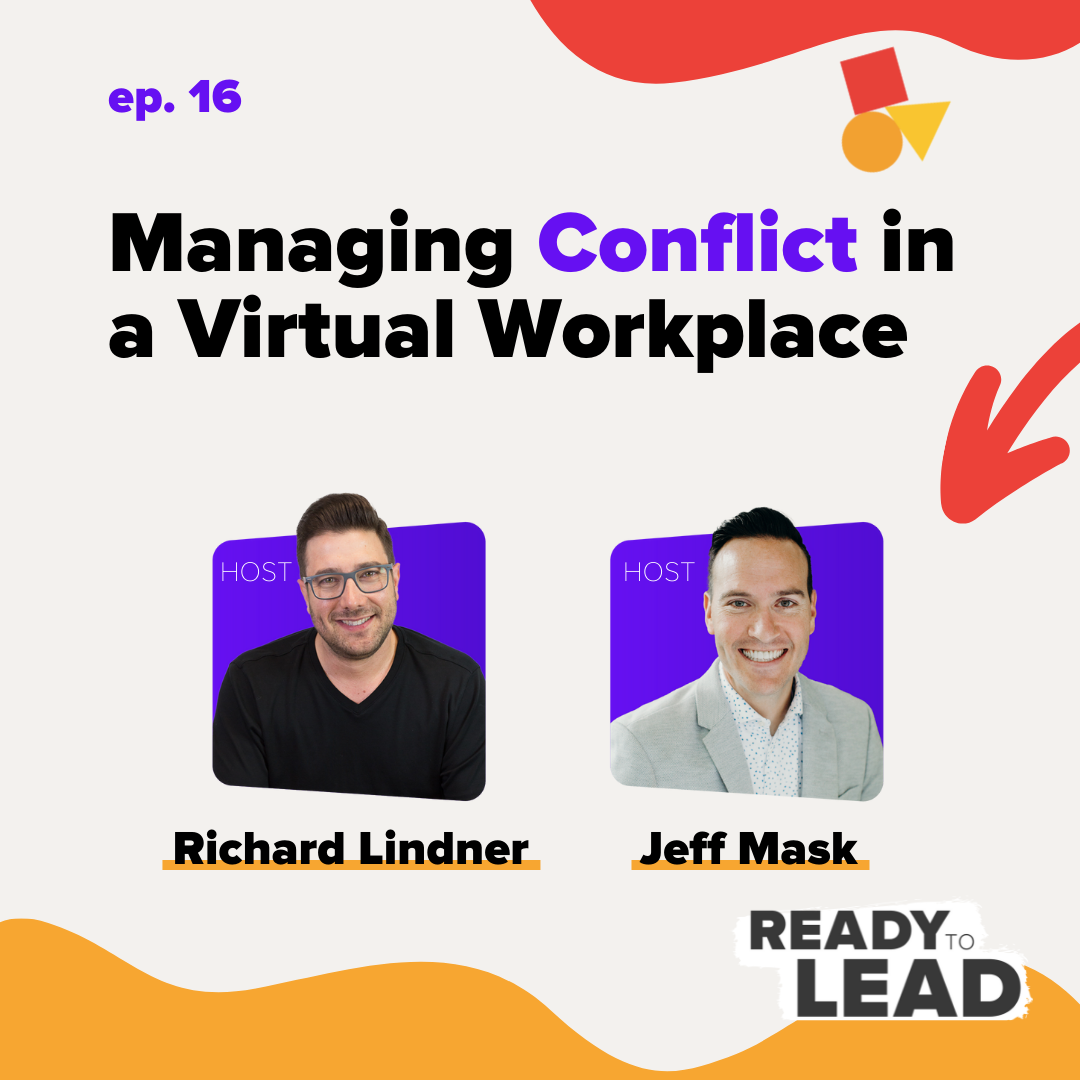Leading people was already difficult in a pre-Covid world, but learning how to engage in healthy conflict is extra challenging in a virtual environment.
It’s a leader’s job to assess human dynamics and behavior and guide people in and through conflict in healthy, productive ways. But it’s so much harder to read people when you’re not face to face, rubbing shoulders with each other every day. Sometimes things might feel okay, but it’s often “artificial harmony” (credit to Patrick Lencioni). It’s difficult for many organizations to get people to speak their truth.
In this episode, hosts Richard Lindner and Jeff Mask speak directly to those leaders who feel like “something’s off” and want to know how to get things back on track. Not by pretending everything’s fine, but by dealing with conflict in a healthy way.
How We View Conflict
Richard prides himself on his ability to “mine for conflict” (another Lencioni term). Years ago, he correctly identified conflict avoidance as one of his weaknesses, so he leaned all the way into it to get the muscle memories, the reps, and make it a strength. Soon he could smell it everywhere. He even started off all of their team meetings with “healthy conflict is good.” But he admits that he’s having more trouble with it right now than he used to when it was one of his weaknesses.
He finds it a lot harder when he doesn’t have that frequent/close in-person connection. He often feels like he doesn’t have enough relational equity to take people to the mat, even for the right reasons. And he knows he’s not alone. When he has this conversation with other leaders, they have so much to say. They’re all feeling it. So, how do they fix it?
Jeff says that, weirdly, one of the reasons he “loves” this pandemic is because anything that was a weakness before is exacerbated now. Why would he love something like that? Because it gives us insight into which aspects of our leadership need to be improved. When you look at it that way, it’s more of a fun quest, rather than a draining exercise. This mindset shift changes everything.
Recognize Conflict and Name It
The first thing you have to do is recognize that conflict exists and name it. Call it what it is. Think back to the 4 Zones of Leadership. The Friend Zone is one of the reasons we avoid the “danger zone” of conflict. We often avoid conflict because we want to be liked. If you continue to avoid going there, the cycle will continue, and your work environment will turn toxic.
In the book, The Three Laws of Performance, authors Steve Zaffron and Dave Logan talk about how the way people perform correlates with how situations occur to them. How we see the world is how we show up. How we see things arises in our speech/language. We need the self-awareness to recognize that other people see things differently than we do.
So, what are some of the signs that we have conflict in our virtual workplace? It’s hard to pick up on context clues from Zoom windows. Richard says they’ve hired team members that don’t live in the area. There are people who have never had consistent shoulder to shoulder time with the rest of the team. They’re not building that sense of trust just from being together. How do we diagnose conflict? How do we know what’s off and where?
3 Common Signs of Conflict
Jeff shares three common signs that there is conflict you need to deal with in your workplace.
Sign #1: When the conversations in public do not mirror the conversations in private. You’re at a leadership team meeting, and someone is saying a, b, and c. Then you’re one on one with that person and they’re saying x, y, z. They’re nodding and smiling in front of the group, then being negative (and honest) in private. That’s a great telltale sign.
Red flag #2: when someone used to be able to deliver results on time, better than expected, and now they don’t, and they haven’t communicated why. Their word isn’t their bond anymore.
Conflict indicator #3: When you can see departments no longer aligning. There’s a lot of infighting and friction. If there’s 2% variance of alignment at the leadership level, you can 10-50x that at a department level. It’s easier to see/detect at the departmental level than at the leadership level. When departments start to go around each other, there’s a lack of trust.
The Stories We Tell Ourselves
Listen to your language. The language you’re using validates the point of view you have. When we have all sorts of stories going on, beliefs we think are true, it’s all stuffed in a dirty closet or junk drawer. How does it feel when you finally organize that junk drawer? A big sigh of relief, right?
We have stories collecting dust in the drawers of our mind that we need to let go of. We have 1.) a persistent complaint about a person. 2.) Then there’s a pattern or behavior that person does that matches what we think. 3.) Then there’s a payoff because I’ve been validated in my complaint and 4.) There’s a major cost to that behavior that hurts.
The stories we tell ourselves form our bias, and our bias becomes truth. And when something validates what we believe, we think there’s no point in having conflict because it won’t change anything. If we think conflict is pointless, then we’re going to avoid it. We have to believe it’s worth it.
The Two Root Reasons We Avoid Conflict
- The human need to be liked
- We believe nothing can change
At the core of both of those? Ego and lack of humility. We need to look at ourselves in the mirror and admit those ego-driven results to ourselves. Our need to be liked and our need to be right. Ask that mirror: “How am I a part of this problem? What have I done to create this?” We have to care enough about people to go there.
As leaders, we are able to change the course of someone’s life, but only if we have the hard conversations. Conflict isn’t dangerous. It’s actually the joy and happiness that comes from achieving something great. If we can see the end from the beginning, we’ll be happy to do it. Just that little moment of awkwardness. Awkward, then onward.
Let’s freaking stop talking about conflict and call it resolution. The goal is the end, not the middle. And the desired end result is alignment. And the responsibility for alignment lies with us, the leaders.
Richard and Jeff want to hear from YOU. Is there a topic you want to dive into? Was something in today’s episode a big aha moment for you? Or did you disagree with something? Email them here with your thoughts/questions: feedback@readytolead.com
RESOURCES:
- The Three Laws of Performance (book by Steve Zaffron and Dave Logan)
- Radical Candor (book by Kim Scott)
- Fierce Conversations (book by Susan Scott)
- Babe’s Tragic Day on YouTube
OTHER SHOWS YOU MIGHT ENJOY:
- Business Lunch with Roland Frasier and Ryan Deiss
- Perpetual Traffic with Ralph Burns and Kasim Aslam
- DigitalMarketer Podcast with Mark de Grasse


